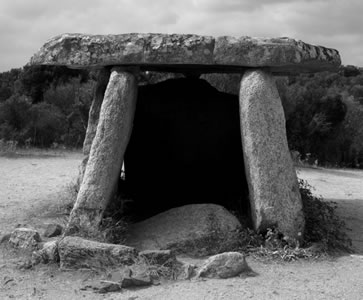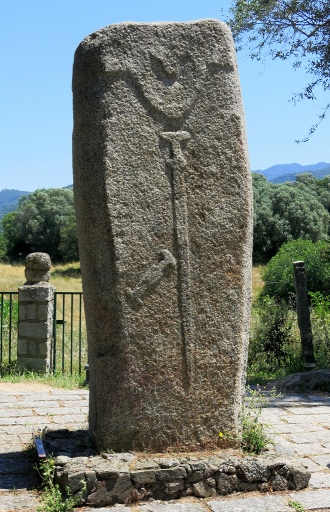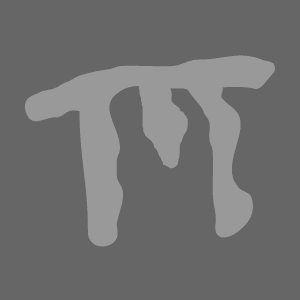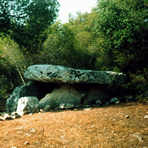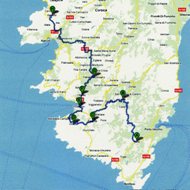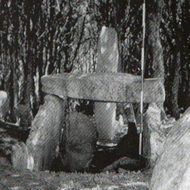|
|
|
|
|
|
|
|
|
|
|

Dolmen Museum

|
|
Prehistory and Early History of the Mediterranean and
Western Europe
|
|
|
|
|
|
|
|
|
|
|
The dating of Corsican dolmen,
based on the astronomical target, are on average more recent than the Sardinians, and
they seem largely realized in the full Bronze Age. This phenomenon
seems to presume
an Iberian origin of the structures which has reached first Sardinia, then Corsica.
As in Sardinia, the buildings seem to be part of a clear path in Corsica too, departing from the strait Palau-Porto Vecchio. |
|
|
|
|
|
|
|
|
|
|
|
|
A.
DOLMEN MONTE ROTUNDU (SOTTA)
In 2500
B.C.,
the astronomical orientation of
dolmen Monte Rotundu was facing Alpha Muscae, as dolmen Ladas in Luras
(in 2800 B.C.) and as dolmen
Su Laccu (in 2400 B.C.) and Elcomis in Buddus˛ (in 2100 B.C.).
Stellar Target:
Azimuth:
198°
Declination: -45.7░
B.
DOLMEN CRUCI I e CRUCI II (LEVIE)
Both the
dolmens had an astronomical orientation facing Alpha
Crucis, respectively in 1400 and 1800 B.C.; the same
stellar system (Centaurus/Crux/Musca) of many Sardinian dolmens,
but in a more recent period (Bronze Age).
Stellar Target:
Cruci
I:
Azimuth:
158
Declination:
-44░6
Cruci II:
Azimuth:
205
Declination:
-43░1
|
|
|
|
|
|
|
|
|
| |
|
C.
ARGHIOLA, FONTANACCIA and RENAGGIU (SARTENE)
Dolmen Arghiola is a very small
one; its room measures m. 1 x 2. Its uniqueness lies in being
built on a slope, so that the entrance of the room is on the
floor, while its back is buried. Beta Crucis, the 2nd brightest
star of the Southern Cross (which, as mentioned, is no longer
visible in the northern hemisphere by about three thousand
years), in 2700 BC, was in front of the entrance of the
structure. The orientation towards the stellar system Centaurus/ Crux / Musca is
the same of many dolmens in Sardinia.
Stellar Target:
Azimuth:
318°
Latitude:
41°34’
Declination: -34.1░
Source: Proverbio, Calledda, Rivista
Italiana di archeoastronomia, Roma 2004.
Dolmen Fontanaccia, at Sartene, is the most famous and visited dolmen
in Corsica. Like Sardinian dolmen Sa Coveccada, it has an astronomical solstitial target (dawn of winter solstice), not a stellar one, as most of these structures. This confirms the relatively recent dating of
this monument referring to the Bronze Age (1800-1500 BC) provided by
its archaeological founds.
Stellar Target:
Azimuth: 128°
Latitude:
41°32’
Declination: -25.00░
Source: Proverbio, Calledda, Rivista
Italiana di archeoastronomia, Roma 2004.
The alignment of Renaggiu is located in an oak forest about 400 meters south of dolmen Fontanaccia and
it consists 40 standing stones, aligned to Betelgeuse in 1500 BC (Middle Bronze Age).
Stellar Target:
Azimuth: 90°
Latitude:
41°32’
Declination:
-0░4
|
|
|
|
Dolmen Arghiola |
|
| |
|
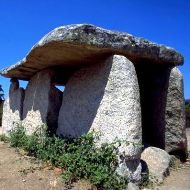 |
|
|
Dolmen Fontanaccia |
|
|
|
|
|
|
|
|
|
|
|
|
|
|
|
|
|
|
|
D.
DOLMEN BIZZICU ROSU or
VACCIL-VECCHIU(GROSSA)
Dolmen Bizzicu Rosu, or Vaccil-Vecchiu, has a direct orientation towards Alpha muscae, in 2200 BC, similar to
dolmen Monte Rotundu, Ladas
at Luras and as Su Laccu and Elcomis dolmens at Buddus˛.
Stellar Target:
Azimuth: 174°
Declination: -46.4░
|
| |
Dolmen
Bizzicu
Rosu |
|
|
|
|
|
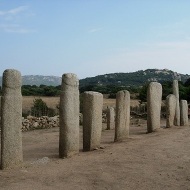 |
|
|
Allignments at Filitosa |
|
|
|
E.
FILITOSA
It 's the most visited site of all Corsica.
Around 1500 BC, some menhirs, two or three meters tall, were lined up on the site around;
their faces were carved with human features, armor and weapons.
For the archaeologist Roger Grosjean,
these statues-menhirs were the chiefs of the enemies killed in battle, so
shown to capture their strength. However, this purpose has not had any effect, because the invaders had the upper hand: the standing stones were thrown to the ground
and divided into parts to reuse them as material for building structures similar to Sardinian
nuraghi (period "Torreano").
The artists have also had an eye for details. The enemy is depicted with an
accentuated hemispheric helmet. Their clavicles and shoulder blades are protected with beads. Long swords are worn on the chest, hanging from a trapeze. The dagger is transversely
attached to a belt with thong.
Roger Grosjean, according to the style of
the clothes and weapons depicted, identified the menhir with the Shardanas warriors,
or the "Sea Peoples" who attacked the Pharaonic Egypt on the twelfth and fourteenth century BC. The same weapons, however, are also worn by the warriors depicted in the "bronze" Sardinian Iron Age, and this fact constitutes one of the main clues for a supposed invasion of Sardinia (and Corsica) by
Shardanas in the iron age.
F.
OLMETO
The dolmens of Olmeto has an orientation towards Alpha Centauri, in 2100 BC, that is always facing the star system Centaurus / Cross / Musca.
Stellar Target:
Azimuth: 150°
Declination: -40.3░
|
|
|
|
|
|
|
|
|
|
|
|
|
Dolmen
Petreto Bicchisano |
|
G.
PETRETO BICCHISANO
Petreto Bicchisano is an exception, for the Sardinian-Corsican dolmen system,
possessing a lunar orientation: it is directed towards the
southern major lunar solstice sunrise. The lunar solstice
orientation, however, is not an exception in the European
megalithic structures and it seems chronologically intermediate
between the star and the solstice ones.
Stellar Target:
Azimuth: 137°
Declination: -0.4░
Leave Petreto Bicchisano, retracing D420 and after about one
km, N196, which you si imbocca a sinistra, in direzione
Ajaccio. After about 38-39 km, at the roundabout, take the 1st exit, towards Bastia-Corte-Bocognano Calvi, and take the N193 for about 4 km. When you come to a roundabout, take the 1st exit and get onto the D81, and you will cross two roundabouts. After about 6.5 km, turn right and go onto the D22, after 3 kilometers, you will reach Appietto. H.
DOLMEN CIUTULAGHIA (APPIETTO)
Dolmen
Ciutulaghia at Appietto has an orientation towards
Alpha Centauri, in 2300
B.C.; towards the stellar system
Centaurus/Crux/Musca again.
Stellar Target:
Azimuth: 147°
Declination: -39.3░
|
|
|

|
|
|
|
|
|
|
|
|
|
|
|
|
|
|
|
|
|
